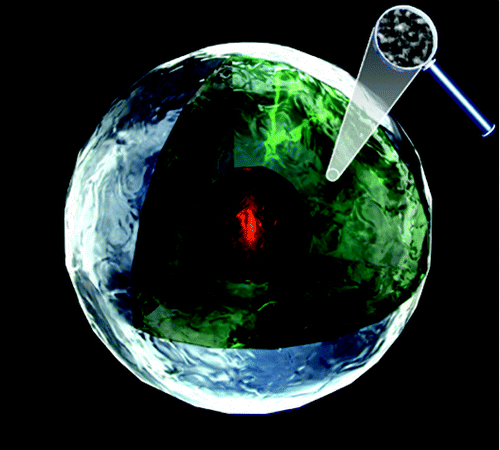当前位置:
X-MOL 学术
›
J. Am. Chem. Soc.
›
论文详情
Our official English website, www.x-mol.net, welcomes your
feedback! (Note: you will need to create a separate account there.)
Multiple Core−Shell Functionalized Colloidal Mesoporous Silica Nanoparticles
Journal of the American Chemical Society ( IF 14.4 ) Pub Date : 2009-08-19 , DOI: 10.1021/ja809346n Valentina Cauda 1 , Axel Schlossbauer 1 , Johann Kecht 1 , Andreas Zürner 1 , Thomas Bein 1
Journal of the American Chemical Society ( IF 14.4 ) Pub Date : 2009-08-19 , DOI: 10.1021/ja809346n Valentina Cauda 1 , Axel Schlossbauer 1 , Johann Kecht 1 , Andreas Zürner 1 , Thomas Bein 1
Affiliation

|
The selective functionalization of the inner and outer surfaces of colloidal mesoporous silica (CMS) nanoparticles with different trialkoxysilanes, following a newly developed delayed co-condensation approach, results in bifunctional CMS. Complementary CMS nanoparticles were prepared with two different functional groups located either on the outer shell or in the inner core of the particle. The identification and localization of the functional groups was achieved by means of different techniques including zeta potential, nitrogen sorption measurements, and fluorescence spectroscopy. This last technique was applied to fluorescein isothiocyanate (FITC)-labeled CMS featuring aminopropyl functional groups on the periphery or the internal pore surface of the particles. Fluorescence quenching experiments were carried out with dodecanethiolate-stabilized gold nanoparticles having a diameter greater than the pore size of the CMS. It could be shown that fluorescence quenching occurs only when the FITC is positioned on the outer surface of the CMS nanoparticles, whereas no quenching was observed for FITC located in the inner core of the nanoparticle. These results clearly confirm the controlled localization of the aminopropyl groups in the nanometer space of the CMS particles. Our approach thus offers the opportunity to synthesize, in a novel multistep co-condensation strategy, various bifunctional mesoporous nanoparticles with controlled localization of different functional groups in the inner core or on the outer shell of the nanoparticle.
中文翻译:

多核壳功能化胶体介孔二氧化硅纳米粒子
使用不同的三烷氧基硅烷对胶体介孔二氧化硅 (CMS) 纳米粒子的内外表面进行选择性功能化,采用新开发的延迟共缩合方法,产生双功能 CMS。互补的 CMS 纳米颗粒由位于颗粒外壳或内核中的两个不同官能团制备。官能团的识别和定位是通过不同的技术实现的,包括 zeta 电位、氮吸附测量和荧光光谱。最后一项技术应用于异硫氰酸荧光素 (FITC) 标记的 CMS,其特征是在颗粒的外围或内部孔表面具有氨基丙基官能团。用直径大于 CMS 孔径的十二烷硫醇稳定的金纳米粒子进行荧光猝灭实验。可以表明,仅当 FITC 位于 CMS 纳米颗粒的外表面上时才会发生荧光猝灭,而对于位于纳米颗粒内核中的 FITC 则没有观察到猝灭。这些结果清楚地证实了氨基丙基在 CMS 颗粒的纳米空间中的受控定位。因此,我们的方法提供了在新型多步共缩合策略中合成各种双功能介孔纳米粒子的机会,这些纳米粒子在纳米粒子的内核或外壳上具有不同官能团的受控定位。可以表明,仅当 FITC 位于 CMS 纳米颗粒的外表面上时才会发生荧光猝灭,而对于位于纳米颗粒内核中的 FITC 则没有观察到猝灭。这些结果清楚地证实了氨基丙基在 CMS 颗粒的纳米空间中的受控定位。因此,我们的方法提供了在新型多步共缩合策略中合成各种双功能介孔纳米粒子的机会,这些纳米粒子在纳米粒子的内核或外壳上具有不同官能团的受控定位。可以表明,仅当 FITC 位于 CMS 纳米颗粒的外表面上时才会发生荧光猝灭,而对于位于纳米颗粒内核中的 FITC 则没有观察到猝灭。这些结果清楚地证实了氨基丙基在 CMS 颗粒的纳米空间中的受控定位。因此,我们的方法提供了在新型多步共缩合策略中合成各种双功能介孔纳米粒子的机会,这些纳米粒子在纳米粒子的内核或外壳上具有不同官能团的受控定位。这些结果清楚地证实了氨基丙基在 CMS 颗粒的纳米空间中的受控定位。因此,我们的方法提供了在新型多步共缩合策略中合成各种双功能介孔纳米粒子的机会,这些纳米粒子在纳米粒子的内核或外壳上具有不同官能团的受控定位。这些结果清楚地证实了氨基丙基在 CMS 颗粒的纳米空间中的受控定位。因此,我们的方法提供了在新型多步共缩合策略中合成各种双功能介孔纳米粒子的机会,这些纳米粒子在纳米粒子的内核或外壳上具有不同官能团的受控定位。
更新日期:2009-08-19
中文翻译:

多核壳功能化胶体介孔二氧化硅纳米粒子
使用不同的三烷氧基硅烷对胶体介孔二氧化硅 (CMS) 纳米粒子的内外表面进行选择性功能化,采用新开发的延迟共缩合方法,产生双功能 CMS。互补的 CMS 纳米颗粒由位于颗粒外壳或内核中的两个不同官能团制备。官能团的识别和定位是通过不同的技术实现的,包括 zeta 电位、氮吸附测量和荧光光谱。最后一项技术应用于异硫氰酸荧光素 (FITC) 标记的 CMS,其特征是在颗粒的外围或内部孔表面具有氨基丙基官能团。用直径大于 CMS 孔径的十二烷硫醇稳定的金纳米粒子进行荧光猝灭实验。可以表明,仅当 FITC 位于 CMS 纳米颗粒的外表面上时才会发生荧光猝灭,而对于位于纳米颗粒内核中的 FITC 则没有观察到猝灭。这些结果清楚地证实了氨基丙基在 CMS 颗粒的纳米空间中的受控定位。因此,我们的方法提供了在新型多步共缩合策略中合成各种双功能介孔纳米粒子的机会,这些纳米粒子在纳米粒子的内核或外壳上具有不同官能团的受控定位。可以表明,仅当 FITC 位于 CMS 纳米颗粒的外表面上时才会发生荧光猝灭,而对于位于纳米颗粒内核中的 FITC 则没有观察到猝灭。这些结果清楚地证实了氨基丙基在 CMS 颗粒的纳米空间中的受控定位。因此,我们的方法提供了在新型多步共缩合策略中合成各种双功能介孔纳米粒子的机会,这些纳米粒子在纳米粒子的内核或外壳上具有不同官能团的受控定位。可以表明,仅当 FITC 位于 CMS 纳米颗粒的外表面上时才会发生荧光猝灭,而对于位于纳米颗粒内核中的 FITC 则没有观察到猝灭。这些结果清楚地证实了氨基丙基在 CMS 颗粒的纳米空间中的受控定位。因此,我们的方法提供了在新型多步共缩合策略中合成各种双功能介孔纳米粒子的机会,这些纳米粒子在纳米粒子的内核或外壳上具有不同官能团的受控定位。这些结果清楚地证实了氨基丙基在 CMS 颗粒的纳米空间中的受控定位。因此,我们的方法提供了在新型多步共缩合策略中合成各种双功能介孔纳米粒子的机会,这些纳米粒子在纳米粒子的内核或外壳上具有不同官能团的受控定位。这些结果清楚地证实了氨基丙基在 CMS 颗粒的纳米空间中的受控定位。因此,我们的方法提供了在新型多步共缩合策略中合成各种双功能介孔纳米粒子的机会,这些纳米粒子在纳米粒子的内核或外壳上具有不同官能团的受控定位。


















































 京公网安备 11010802027423号
京公网安备 11010802027423号